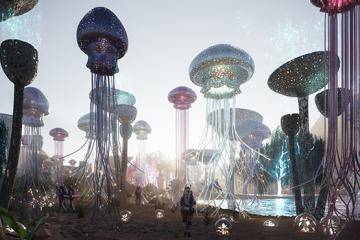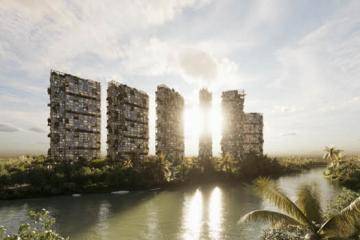Nouvelles
Lisez les derniers développements d'ITOOSOFT

Discover how Garage Farm supports iToo to make 3d renders look better and 3d artists’ lives easier
Over at our online render farm, we get a lot of projects that feature photorealistic Architectural exteriors, and it comes as no surprise that most of these renders make use of IToo’s plugins. Imagine this: you have spent weeks perfecting your 3d render of an architectural project. Finally, your client has approved it--congratulations! Now comes your next task: generating a realistic environment--be it a tree-shrouded mountainside or a sprawling cityscape--in which you’d situate your building and showcase its beauty from different angles.
Wouldn’t it be a shame to surround your painstakingly-crafted building with plastic-looking trees, toy-ish grass and shrubs, and stiff, flat buildings? And wouldn’t it be more of a shame if you’d have to spend more time crafting trees and buildings yourself just to have a convincing background?
If photorealism is what you are after, paying attention to the smallest things in your image is absolutely critical. Literally every bit helps. Even if just as small a thing as the scattering of rocks or the sway of the grass looks computer-y and unnatural, it can make the whole image much less convincing and ruin the illusion for the viewers that what they are looking at is a photograph and not a 3D render.
But paying attention to the peripheral elements of your image takes time and in archviz, time is money. You want to be spending the most time on the actual architectural structure (or vehicle or industrial product) you were commissioned to render and less time trying to make the other buildings, trees, traffic, people, and objects look real.
Enter iToo plugins. iToo has “everything you need for artist-friendly scattering, scene assembly, parametric modelling, and procedural layout.” What this means is that with iToo, you can pretty much automate building the world around your main 3d subject.
Say what?
Yes, you read that right--automate. iToo plugins are the industry standard for generating realistic environmental elements that can support your archviz projects. From trees to rocks to cars to people to full cityscapes, iToo plugins can build realistic, detailed worlds with just a few inputs. In fact, many of our customers at GarageFarm.NET rely on at least one of the Itoo plugins, which is why we stay up to date on our support of the IToo catalogue.
Let’s take a closer look at what iToo can do for you.
How RailClone saves you time
iToo’s most popular plugins are RailClone and Forest Pack. RailClone is a parametric modeling plugin while Forest Pack is an all-purpose scattering tool for various objects and even light.
RailClone saves you time by automating the generation, layout, and variation of complete structures using only a handful of base objects as a starting point plus a set of rules dictating how the base objects should be used. As usual with anything 3d, it’d be easier to show you:
>
As mentioned in the video, RailClone doesn’t generate objects out of thin air.
The key to how RailClone works are its operators. These are the commands that allow you to modify and vary certain characteristics for the generated objects. Otherwise, you’d have to go in and add variations to the object one-by-one. That’s a bummer. Also without operators, all the bus shelters in the example above would look identical. Unless identical objects are what you are after, uniformity is usually not good for photorealism.
And make no mistake: RailClone can create so much more than bus shelters. iToo has an extensive library of ready-made assets for Railclone called The Parametric Library that can further simplify building an environment for your projects.
>
In a full-CG music video by Bloc D, pretty much all of the environment--the cities, buildings, tunnels, even the train yard--was created with RailClone. RailClone isn’t just for archviz artists.
>
How Forest Pack saves you time
Forest Pack on the other hand saves you time by allowing you to “use over 100,000 objects each with 1 million polys, and render in just a few minutes.” What this means is that with Forest Pack, you won’t have to painstakingly position every blade of grass, every wisp of cloud, or every piece of rock in your scene just to make it look photorealistic.
At its core, iToo’s Forest Pack is a scattering plugin. Now that might sound weird; you might be asking now, “What’s scattering got to do with photorealism?” At the risk of oversimplification, there’s two ways that Forest Pack’s scattering algorithms help with photorealism. For one, natural objects like shrubs in the woods have a randomized way of occurring in nature. Look at this photo:
>
All right, so this is not a photo. This is a render using Forest Pack. Notice how the blades of the tall grass have a way of sticking out that seems natural to our eyes. Or how the shorter grass in the middle of the dirt road clumps naturally. Or even the smatterings of twigs and branches on the dirt road. If the sticking out and the clumping and the smattering is too uniform, too “stiff”, the human eye (actually the brain) will quickly detect this unnatural uniformity and just as quickly decide that this isn’t a photo but a render (a poor one at that). Forest Pack algorithms have absolutely nailed that formula for randomizing distribution across a defined space in such a way that the distributed objects look “natural”, whether it’s water lilies or tree stumps.
Imagine trying to do this manually for your scenes. Safe to say you’ll never meet any deadline again.
And don’t be misled by the name “Forest Pack.” While it does indeed have a deep library of presets for vegetation and landscape elements, Forest Pack can also work its scattering magic using any other geometry--meaning, if you have previously modeled or downloaded cars or marbles or people, Forest Pack can use those and populate a scene with them.
The second way that Forest Pack’s scattering algorithms help with photorealism (and with meeting your deadline) is by scattering light realistically. You see, different surfaces react with light differently. Let’s say you already finished rendering a scene and the client wants you to add light fixtures to it. Let’s say this is the scene you initially rendered:
>
With Forest Pack, it’s possible to add light fixtures to this scene even after you’ve already rendered (partnered with Corona Lightmix, that is). Forest Pack’s algorithm will take into account the different surfaces you have in your scene and determine how light will react with each of them, yielding a natural and realistic illumination of the scene. Like so:
>
Now if that isn’t a time-saver, then nothing is.
How GarageFarm.NET can save you even more time!
Even with an extremely efficient production pipeline, missed deadlines are still a thing. That’s because one of the tightest bottlenecks of a project is actually rendering them! The essential tools of the trade go beyond the main DCC, and plugin issues on a third-party cloud rendering service can easily derail timelines for deliverables by days or weeks. At GarageFarm.NET, our team of Developers, IT Admins and Wranglers all help to make sure we support the latest releases of IToo software among other popular plugins for 3ds Max. Besides that, our support team consists of experienced 3d professionals ready to assist you in real-time 24/7.
RailClone + Forest Pack = Beauty
What RailClone and Forest Pack do under the hood are nothing short of feats of technological brilliance but at the end of the day, what matters is how they look. Some of the world’s top archviz firms regularly turn to RailClone and Forest Pack for their projects and the results are absolutely gorgeous. Just take a look at the work by our customers ZUH and Eves Visualization. If you can tell the renders from the photos, congratulations.
(I’m messing with you. They are all renders done with the help of iToo plugins.)
So if you are a 3ds Max user and are still not using iToo plugins, you are leaving a lot of beauty, photorealism, and potential clients on the table.


